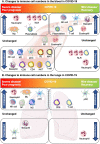Neutrophilia, lymphopenia and myeloid dysfunction: a living review of the quantitative changes to innate and adaptive immune cells which define COVID-19 pathology
- PMID: 35593707
- PMCID: PMC8371938
- DOI: 10.1093/oxfimm/iqab016
Neutrophilia, lymphopenia and myeloid dysfunction: a living review of the quantitative changes to innate and adaptive immune cells which define COVID-19 pathology
Abstract
Destabilization of balanced immune cell numbers and frequencies is a common feature of viral infections. This occurs due to, and further enhances, viral immune evasion and survival. Since the discovery of the Severe Acute Respiratory Syndrome coronavirus 2 (SARS-CoV-2), which manifests in coronavirus disease 2019 (COVID-19), a great number of studies have described the association between this virus and pathologically increased or decreased immune cell counts. In this review, we consider the absolute and relative changes to innate and adaptive immune cell numbers, in COVID-19. In severe disease particularly, neutrophils are increased, which can lead to inflammation and tissue damage. Dysregulation of other granulocytes, basophils and eosinophils represents an unusual COVID-19 phenomenon. Contrastingly, the impact on the different types of monocytes leans more strongly to an altered phenotype, e.g. HLA-DR expression, rather than numerical changes. However, it is the adaptive immune response that bears the most profound impact of SARS-CoV-2 infection. T cell lymphopenia correlates with increased risk of intensive care unit admission and death; therefore, this parameter is particularly important for clinical decision-making. Mild and severe diseases differ in the rate of immune cell counts returning to normal levels post disease. Tracking the recovery trajectories of various immune cell counts may also have implications for long-term COVID-19 monitoring. This review represents a snapshot of our current knowledge, showing that much has been achieved in a short period of time. Alterations in counts of distinct immune cells represent an accessible metric to inform patient care decisions or predict disease outcomes.
Keywords: B cells; SARS-CoV-2; cell counts; clinical; lymphocytes; lymphopenia; monocytes; neutrophilia; neutrophils; prognosis; recovery; severity.
© The Author(s) 2021. Published by Oxford University Press.
Figures

Similar articles
-
Immune response to SARS-CoV-2 and mechanisms of immunopathological changes in COVID-19.Allergy. 2020 Jul;75(7):1564-1581. doi: 10.1111/all.14364. Allergy. 2020. PMID: 32396996 Free PMC article. Review.
-
Hematopathology of Severe Acute Respiratory Syndrome Coronavirus 2 Infection and Coronavirus Disease-19.Surg Pathol Clin. 2023 Jun;16(2):197-211. doi: 10.1016/j.path.2023.01.007. Epub 2023 Feb 2. Surg Pathol Clin. 2023. PMID: 37149356 Free PMC article. Review.
-
How does the Immunological System Change during the SARS-COV-2 Attack? A Clue for the New Immunotherapy Discovery.Curr Med Chem. 2023 Sep 18. doi: 10.2174/0929867331666230918092749. Online ahead of print. Curr Med Chem. 2023. PMID: 37723634
-
Impact of SARS-CoV-2 in Hematopoietic Stem Cell Transplantation and Chimeric Antigen Receptor T Cell Therapy Recipients.Transplant Cell Ther. 2021 Sep;27(9):796.e1-796.e7. doi: 10.1016/j.jtct.2021.07.005. Epub 2021 Jul 10. Transplant Cell Ther. 2021. PMID: 34256172 Free PMC article.
-
The underlying changes and predicting role of peripheral blood inflammatory cells in severe COVID-19 patients: A sentinel?Clin Chim Acta. 2020 Sep;508:122-129. doi: 10.1016/j.cca.2020.05.027. Epub 2020 May 14. Clin Chim Acta. 2020. PMID: 32417210 Free PMC article.
Cited by
-
Neutrophil-to-Lymphocyte Ratio (NLR) Is a Promising Predictor of Mortality and Admission to Intensive Care Unit of COVID-19 Patients.J Clin Med. 2022 Apr 16;11(8):2235. doi: 10.3390/jcm11082235. J Clin Med. 2022. PMID: 35456328 Free PMC article.
-
Impact of mRNA COVID-19 vaccination on hematological parameters in patients maintained on clozapine: A retrospective study from Qatar.Explor Res Clin Soc Pharm. 2025 May 18;19:100614. doi: 10.1016/j.rcsop.2025.100614. eCollection 2025 Sep. Explor Res Clin Soc Pharm. 2025. PMID: 40502459 Free PMC article.
-
Cellular Immune Profiling of Lung and Blood Compartments in Patients with SARS-CoV-2 Infection.Pathogens. 2023 Mar 11;12(3):442. doi: 10.3390/pathogens12030442. Pathogens. 2023. PMID: 36986364 Free PMC article.
-
Hematological parameters and their predictive value for assessing disease severity in laboratory-confirmed COVID-19 patients: a retrospective study.Am J Blood Res. 2023 Aug 15;13(4):117-129. eCollection 2023. Am J Blood Res. 2023. PMID: 37736538 Free PMC article.
-
Eosinophils and COVID-19: Insights into immune complexity and vaccine safety.Clin Transl Allergy. 2025 Mar;15(3):e70050. doi: 10.1002/clt2.70050. Clin Transl Allergy. 2025. PMID: 40120088 Free PMC article. Review.
References
-
- Liao M, Liu Y, Yuan J. et al. Single-cell landscape of bronchoalveolar immune cells in patients with COVID-19. Nat Med 2020;26:Art. no. 6. doi:10.1038/s41591-020-0901-9. - PubMed
Publication types
Grants and funding
LinkOut - more resources
Full Text Sources
Research Materials
Miscellaneous
